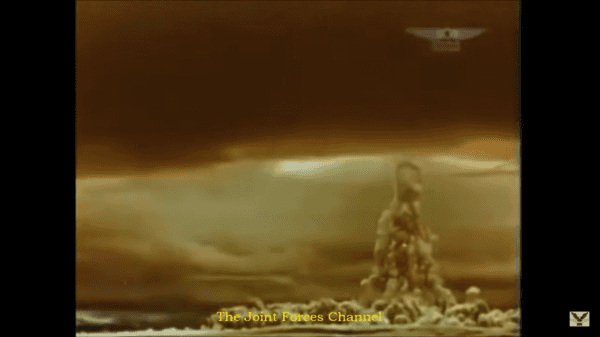This chilling video shows the effects of the most powerful nuclear weapon ever tested in human history. The weapon was a 50-megaton hydrogen bomb also known as the Tsar Bomba tested on Oct. 30, 1961 by the Soviet Union.
Despite the technological advances made since the Tsar Bomba test drop, it remains the most powerful nuclear weapon ever to be tested by humankind.
Tsar Bomba had the capacity to produce as much as 100 megatons, but the fallout would have been disastrous and the pilot of the plane would have been killed since he wouldn’t have had enough time to fly into safety. The Soviets instead decided to minimize nuclear fallout by installing a lead tamper instead of a uranium-238 fusion tamper, which would have amplified the reaction, according to the Atomic Heritage Foundation.

(The Joint Forces Channel/YouTube)
The Tsar Bomba was delivered by a Tu-95V Soviet long-range bomber piloted by Major Andrei Durnovstev. The bomber was escorted by a Tu-16 observer plane that had the responsibility of collecting air samples and taping the test.
It was dropped at an altitude of 34,000 feet, and detonated at 13,000 feet during midday over the Mityushikha Bay Nuclear Testing Range in the northern Arctic Circle.
Take a look at the planning and detonation below:
Tsar Bomba weighed 59,525 lbs., was 26 feet in length and 6.9 feet in diameter. Tsar Bomba was attached to a parachute weighing nearly 1,800 lbs., allowing the bomber and observer plane time to fly to safety before detonation. Both pilots only had a 50 percent chance of survival.
The explosion was so large it was picked up by seismic stations all over the world. The seismic shock created by the detonation was measurable even on its third passage around the Earth, and even blew out windows in Norway and Finland.
Tsar Bomba was some 1,570 times stronger than the combined power of “Fat Man” dropped over Nagasaki and “Little Boy” over Hiroshima in 1945. It was even 10 times stronger than all weapons detonated in World War II combined.

(The Joint Forces Channel/YouTube)
The bomb was dropped under the orders of Nikita Khrushchev during his reign over the Soviet Union. Khrushchev hoped that the display would strike fear into the hearts of Americans and display the Soviet Union’s nuclear capabilities. The bomb was dropped in the Novaya Zemlya archipelago, off the northern coast of Russia, but its effects were felt all over the world.
The Tsar Bomba was also called the “Kuzkina mat.” Many speculate that this was a huge warning to the U.S., since Khrushchev vowed at a 1960 United Nations General Assembly, he would show the U.S. a “Kuzkina mat,” which also roughly translates to “We’ll show you.”



